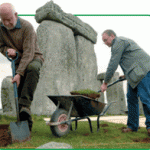 Archaeologists broke ground at Stonehenge last week for the first time since 1964, with the aim of using modern technology to pinpoint just when builders dragged the first bluestone pillars to the site some 4500 years ago. The team, which is re-excavating a trench originally dug in the 1920s, plans to analyze short-lived organic material such as twigs or grains with mass spectroscopy. They hope to establish the arrival date of the stones to within a couple of decades.
Archaeologists broke ground at Stonehenge last week for the first time since 1964, with the aim of using modern technology to pinpoint just when builders dragged the first bluestone pillars to the site some 4500 years ago. The team, which is re-excavating a trench originally dug in the 1920s, plans to analyze short-lived organic material such as twigs or grains with mass spectroscopy. They hope to establish the arrival date of the stones to within a couple of decades.
The dig leaders, Geoffrey Wainwright of the Society of Antiquaries of London and Timothy Darvill of Bournemouth University in the U.K., are looking to bolster their theory that bluestones–dragged 250 kilometers from the Preseli Hills in Wales–were valued for their healing powers. Inscriptions in Wales reveal that locals considered the stones magical. And deformed skeletons recently dug up nearby may have been from pilgrims seeking cures. Precisely dating the different building stages of the monument is “wrapped into a series of interesting debates” about pottery, metallurgy, and spirituality in northwest Europe, says Darvill. The project is part of a broader National Geographic-sponsored effort covering nearby Neolithic sites.
Originally appeared in Science Magazine as a Random Sample: [html] [pdf]